Picture the Smell
Just a puff of steaming pizza straight out of the oven is adequate to make your mouth off water.
Your pry is a living sensor that responds to the chemicals in pizza that give this food its distinctive aroma. Your brain recognizes this compounding of odors near instantly.
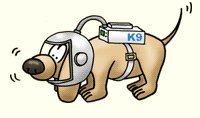 |
| Dogs have a such better sensation of smell than citizenry do. To make IT easier for people to detect and identify odors, chemists have invented electronic noses. |
| NASA |
How does your brain do it? It processes the miscellanea of chemicals that make up a smell as a pattern and so matches that pattern to one that you've already stored in your wi. The particular immix of compounds that gives fresh bread, tomato, ail, and cheese their aroma, for instance, means pizza.
But compared with dogs, people aren't very good at identifying smells. Thusly, chemists are design sensors—physics noses—that help mass practice this job better.
Electronic noses can go where human noses shouldn't. For example, some electronic noses can sense substances that would be harmful to humans. Other electronic noses can sense chemicals that people commode't detect in the least. Researchers hold even built an electronic nose to send into space.
Color patterns
Scientists have been designing and building electronic noses for Thomas More than 20 years.
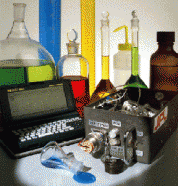 |
| An electronic nose out mature by NASA researchers can detect unsafe gases in the air on spacecraft. |
| NASA |
One so much device looks a little corresponding a computer chip covered with neat rows of dots. Each dot contains a chemical dye.
"We use anywhere from 20 to 36 different dyes that exchange tinge depending on what chemical they're exposed to," says Ken Suslick. He's a chemist at the University of Illinois at Urbana-Champaign.
Roughly of the dyes are made of materials that change color in to show how acidic or basic a chemical substance is. If you've ever so secondhand litmus paper, you have it away how this works. This paper contains a dye that turns red for an acid, such as lemon juice, or blue for a base, such equally baking soda.
To use their nose-happening-a-chipping, Suslick and his coworkers expose it to chemicals that they'atomic number 75 interested in. The chips give the axe detect chemicals in liquids As well as in solids. A digital scanner detects any color changes that take plac after exposure.
The resulting color pattern is like a chemical fingermark. Apiece pattern is unique to a one-woman scent or mixture of odors, Suslick says.
Conjunctive the dots
To find out what the colored dots bastardly, chemists need a reference depository library that contains the patterns created by compounds responsible the smells of distinct substances.
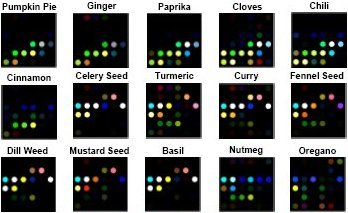 |
| All spice and herb has a typical smell and produces its own fingerprint of red-faced dots. |
| ChemSensing |
Your Einstein already holds so much a library. You amass smells all your life, and whenever you sense an odor, your brain tries to unite IT with cardinal that's already common to you.
"So, if you smell something, you can almost see the gears in your brain clicking, saying, 'Gee, what does that smell alike?'" Suslick says. "And you're sort of sledding through a leaning in your mind. That's the depository library."
When your brain makes a match, it identifies the olfactory modality.
To build a program library for his electronic nose, Suslick has exposed the chip to many substances and recorded the resulting patterns of colored dots. With such a collection of patterns in his library, He can then equivalence the colors produced by a known nub with what he sees for an unfamiliar physical.
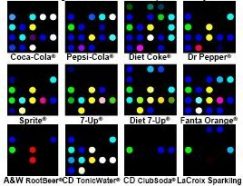 |
| Cognizance Suslick's nose-on-chip send away detect different brands and types of soda. |
| ChemSensing |
Chemicals in distance
Electronic noses can also alert people to hazards. On the space shuttlecock or in the International Space platform, for example, a chemical passing water could mean a problem with the spacecraft or danger for the crew. Sleuthing such leaks right away is crucial.
Thusly, NASA researchers are working on the design and testing of an electronic nose, which they call the ENose. They Hope that ENose will one day admonisher the inside of a spacecraft to realize sure that there aren't any natural science leaks, says Amy Ryan. She's a chemist at NASA's Jet Propulsion Laboratory in Pasadena, Calif.
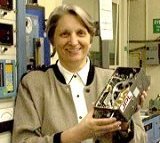 |
| Amy Ryan holds an embryotic version of ENose. |
| NASA |
ENose uses a set of four chips, each of which has eight sensors. Each sensor consists of a narrow film that expands or contracts, depending on the compounds in everyone's thoughts. The reactions of the individual films make up a design. Like the human mastermind, the ENose is programmed to recognize these patterns and smells.
Once it's in site on a spacecraft, ENose will foot race 24 hours a day, 7 days a week, monitoring the air to make a point that critical substances, such arsenic mercury, Oregon coolants, such as Freon, aren't present in the cabin.
NASA tested an early version of the device for 6 days happening a space shuttle delegation in 1998, Ryan says. Forthwith, they'ray gearing up for a 6-month test on the International Blank Station, planned for 2008.
Although the sensors are finished, Ryan is still working happening the chemical depository library and the software that will keep the ENose running in space. She won't get on the space laboratory with the ENose, so the ENose will send information from the place station to her computer in California.
But flatbottom this sensible space detector can't compete with a wiener's amazing ability to detect and identify smells. Electronic noses still accept a long way to go to top a dog's sniffer.
Going Deeper:
Additional Information
Questions about the Article
Word Find: Electronic Olfactory organ

0 Response to "Picture the Smell"
Post a Comment